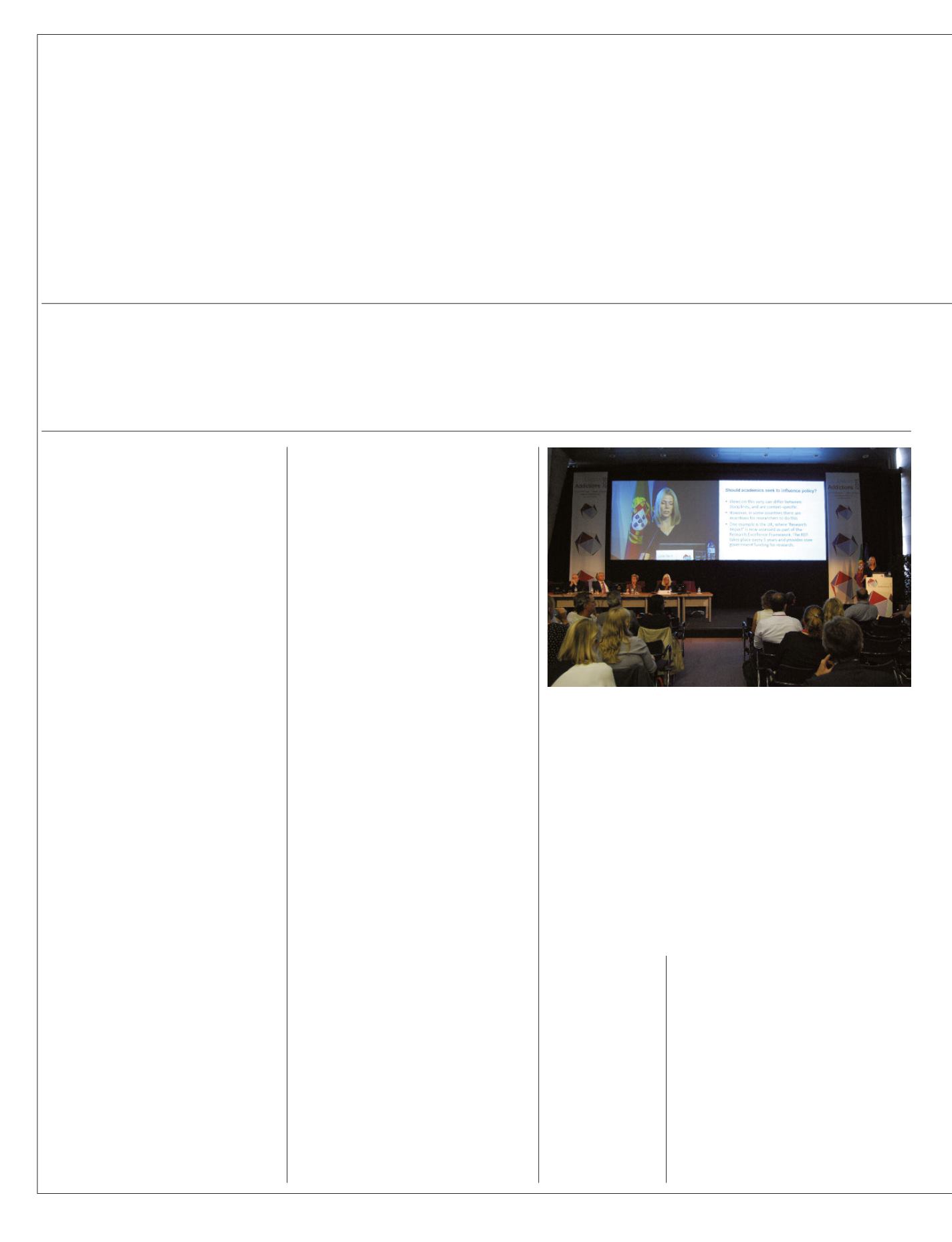
News Focus
10 |
drinkanddrugsnews
| October 2015
‘ADDICTIONS, ABOVE ALL, ARE A
HEALTH PROBLEM
– but they can’t be
solved by health interventions alone,’ state
secretary to the Portuguese Ministry of
Health, Fernando Leal Da Costa, told
delegates at the opening session of
Lisbon
Addictions 2015
. Portugal’s groundbreaking
policy of decriminalising personal drug
possession was one that other countries
could learn from, he said. ‘We acknowledge
that it’s not perfect, but we do believe that
it’s a sensible and rational approach.’
The policy had been fully monitored and
the plan was now to further develop it in
cooperation with other Portuguese-speaking
countries, he said – ‘a way to expand our
interventions’. However, Portugal was
struggling with the reintegration of people
who’d had drug problems, particularly in
terms of employment opportunities in the
current economic climate, and was aware that
more needed to be done in terms of
prevention. ‘Much more also needs to be
done, Europe-wide, on the issue of alcohol,’ he
stated. ‘We need to revisit the alcohol strategy
in terms of the whole continent.’
Even defining addiction could present
problems, said Robert West of University
College London. ‘It’s a complicated subject, with
a lot of different components. But we do know
that it arises out of learning, which means
there’s a huge overlap between neuroscience
and behavioural science.’The question was
how to get the best return on investment – not
necessarily in monetary terms, but in terms of
benefit to society, he said.
There was a tendency for people in the
field to compartmentalise their favourite
model of addiction, he pointed out, whether
that related to ‘reward, self-medication, relief
from withdrawal, habit, acquired drive’ or
other models. ‘All of them have some validity,
and in terms of interventions we can educate,
persuade, coerce, incentivise, enable, restrict
and more. They’re broad-brush things, but all
will be relevant at some point.’
For any behaviour to occur, three things
had to be in place, he said – capability,
motivation and opportunity. ‘So if we do ever
manage to crack the problem of addiction,
that would be quite a scary thought – it
means someone will have a very powerful
behaviour-change tool at their disposal.’
Policies and interventions could be informed
by neuroscience, he said, and it was now time
for a ‘major review of the research strategy
underpinning the approaches we take to
combatting addiction. I don’t mean a bunfight
about where the money goes – just an
analysis of how we do it.’
‘There are many levels of ongoing research
that are essential to understanding addiction
and effective interventions,’ added
neuroscientist Marina Picciotto of Yale
University. ‘But we do need research that
determines the efficacy of the interventions
out there.’ One example was Alcoholics
Anonymous, she told delegates. ‘Are there
options that aren’t being used because there’s
this dominant paradigm?’
Neuroscience research had permeated the
study of addiction, and public policy, to the
extent that it was now ‘practically invisible’
she said, and had been highly successful in
developing new interventions. ‘It can identify
the primary molecular targets for drugs of
abuse, as well as defining circuits,
neurotransmitter systems and the really long-
term changes that can explain cue and use
and so on. It’s even defined the exact
molecules in the brain that nicotine binds to.’
However it was important to remember
that neurobiology and holistic approaches
were not mutually exclusive, she stressed. ‘We
do need hybrid neurobiological and
behavioural interventions based on what we
know about neural systems, and we need to
get beyond the “one pill will fix it” philosophy.’
‘The world is a very complicated place,’
agreed Robert West. ‘It’s about finding the
right angles to approach things from.’
On the issue of whether treatment was
even the correct first response to addiction
problems, Mark Kleiman of UCLA’s Luskin
School of Public Affairs told the conference
that ‘most people who use habit-forming
substances do not go on to form bad habits,
with the exception of nicotine. With all other
substances, rates from initiation to problem
use are low. Addiction is not a characteristic
property of the use of addictive materials, and
I’d also say that most people recover
spontaneously – that is, without formal
interventions.’
However, spontaneous recovery was
usually a reaction to outside events, he
stressed – ‘getting a job, pressure from loved
ones, things like that. Most people who seek
help do so through voluntary self-help
programmes such as AA, and the outcomes
tend to be just as good as paid treatment. So
THE APPLIANCE
The first pan-European multi-disciplinary conference on addictive
behaviours looked at how science and research can translate into
policy and practice.
DDN
reports
‘We have to show that there’s a
positive impact on society or
the economy... to improve the
supply of evidence – but that
tends to ignore the importance
of other factors. It’s very often
a long game.’
LINDA BAULD


